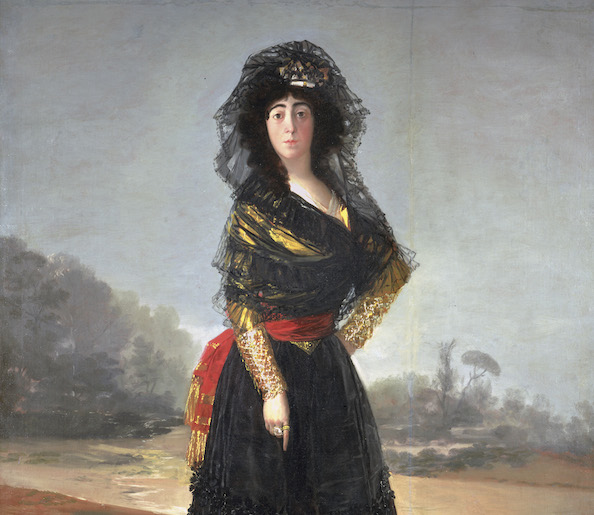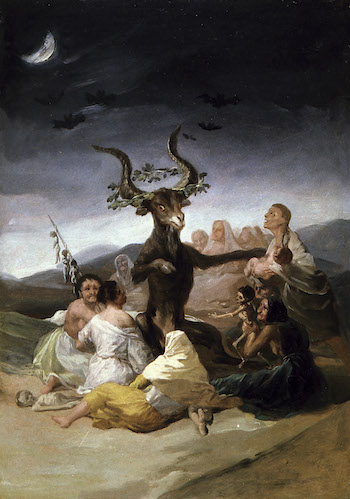Visual Arts Review: “Goya: Order and Disorder” — A Mountain of Superlatives
Whatever Goya you hope to find, the MFA has you covered.
Goya: Order and Disorder at the Museum of Fine Arts, Boston, through January 19, 2015.

María del Pilar Teresa Cayetana de Silva Álvarez de Toledo y Silva, Thirteenth Duchess of Alba, Francisco Goya y Lucientes, 1797. Photo: courtesy, Museum of Fine Arts, Boston.(Cropped)
By Franklin Einspruch
One could heap superlatives upon Goya: Order and Disorder at the Museum of Fine Arts, Boston for a long time before the pile grew unseemly. The MFA is displaying its own fine Goya holdings alongside 21 loans from the Prado, with still more works hailing from the Louvre, the Uffizi, the Metropolitan Museum, the National Gallery, the MFA Houston, the San Diego Museum of Art, and an assortment of private collections that you and I will likely never enter. The exhibition has, among other things, reunited portraits of the Duchess and Duke of Alba that have been separated for 300 years, put on view the first bound volume of Goya prints ever acquired for an American collection (that of the Boston Athenaeum), and included a scope of paintings, drawings, prints, and tapestries that captures the enormous breadth of the artist’s creative production.
This is likely the most important exhibition on the New England museum calendar for a year prior or hence, and that’s with a consummately excellent show of Alexander Calder up right now at the Peabody Essex Museum that would otherwise deserve the honor, and the MFA’s own scintillating Sargent watercolor show from last fall not at all forgotten. Goya is appearing here at the MFA and here alone, after which time your next Madrid itinerary will have to include the Fundación Lazaro Galdiano if you want to see the Witches’ Sabbath (1791–98).

Witches’ Sabbath, Francisco Goya y Lucientes, 1797–1798. Photo: courtesy, Museum of Fine Arts, Boston.
If there’s a criticism to make, it’s that the hands of the curators lay heavy on the exhibition. The organization is thematic rather than chronological. Nowadays that’s as commonplace as anachronistically staged productions of Shakespeare; it might be radical to go chronological again. This in itself is entirely acceptable, of course, but Order and Disorder is sectioned off into eight categories, which are further divided into upwards of six subcategories. The show is huge— the largest Goya retrospective in 25 years, according to the MFA, with 170 works in total—but the imposition of three dozen conceptual compartments is overstated. It’s the curse of the art historian to be able to elucidate everything about a work of art except the part that matters, the awe that it inspires. That said, the times demand that everything be explained, and an institution would as soon leave a museumgoer deprived of outergarments as wall labels. I admit that this is my own gripe. The exhibition is a crowning achievement for curator Stephanie Loeb Stepanek, as well as the outgoing director Malcolm Rogers.
Frederick Ilchman, who curated Order and Disorder along with Stepanek, cites the section entitled “In the Balance” as central to Stepanek’s thinking about the show as a whole. Notable among the works included here is a chalk drawing of a figure riding on roller skates—a new invention at the time—with arms splayed, mouth agape, and clearly, as we say in the world of contemporary urban recreations, about to eat it. Crazy Skates (1824–28) showcases Goya’s extraordinary facility as a draughtsman, but so does everything else on view. Distinctive here is the confluence of themes that characterize the master’s work: the flying figure, the sharp awareness of fashion and the goings-on of society, and the admixture of the comedic and the tragic that gives much of Goya’s work its poignancy. “Three parts of joy, one of mourning—that is the taste of life,” wrote Jean Giono. In Goya the ratio can go the other way with a vengeance, leaving nothing of joy but absurdity, but the tone remains always complex. Also, in the case of Crazy Skates, the marks constitute a kind of proto-expressionism. Even the hatching on the man’s jacket is a frenzy. (In the background there is what its inventor called a Laufmaschine, an early form of the bicycle. Astonishment at the world of personal technology had begun.)
Still Life with Golden Bream (1808–12) is a technical masterpiece, but again with hints of expressionism that presage paintings from over a century later. The round eyes of the bream are full of comic surprise, but their piling isn’t so different than similar mounds of corpses in some of Goya’s etchings. The fish, however doomed, glow with a light from within as the riverbank and the night creep up on them. The painting seems to evoke, preternaturally, everything.
There is too much work in Order and Disorder to account for it all in a single review. I’ll say instead that whatever Goya you hope to find—Goya the portraitist to nobility, Goya the satirist, Goya the mystic, Goya the moralist, Goya the recorder of history, Goya the painter to the Catholic Church, Goya the critic of the Catholic Church, even Goya the decorator—the MFA has you covered. The Disasters of War and The Sleep of Reason are here. A room has been given over to the oil portraits, which seem to stand out even in relation to the other material. The star of the room is the Duchess of Alba, painted in 1791. A golden swath of sunlight cuts behind the black-mantillaed subject, her forefinger pointing down in a defiant gesture that not coincidentally points out an inscription in the dirt at her feet, “Solo Goya.” In other words, only Goya could have brought this into being.
Perhaps no one so cannily captured the way that bright light looks from a position in darkness. Yard with Madmen (1794) shows the sun filling the air of the courtyard with holy, incorporeal luminescence that contrasts with the romping yahoos below. Another example is Self-Portrait While Painting (c. 1795), which adorns the cover of my spine-broken copy of Max Doerner’s The Materials of The Artist, and which I never thought I would see in person. It belongs to the collection of the Museo de la Real Academia de Bellas Artes de San Fernando, in Madrid, and it’s a little thing, a foot high or so. Doerner doesn’t have much to say about Goya, noting that he generally painted on bole grounds (basically white lead oil paint and red clay, an example of which can be seen in the unfinished portrait of Maria Luisa de Borbon y Vallabriga from around 1800) and goes on to comment
On these he worked freely with white, achieving a peculiar charm of mother-of-pearl tones by the subsequent use of superimposed varnish glazes. Individual colors were never forced beyond the general tone of the picture.
Nevertheless, it’s around here that the spine of my book is broken. “Tone” is a slippery term in painting. Nowadays people say that it’s synonymous with value, the lightness or darkness of a color, but that’s not how Doerner used the word, nor Matisse, nor Gauguin. Coming out of their pens it means something more like “feeling.” This marshaling of tones, understood as color, value, emotion, or the three of them together, is the essence of the problem of art, and Goya solved it, again and again.
Franklin Einspruch Franklin Einspruch is a Boston-based artist and writer. His website is einspruch.com; follow him on Twitter @franklin_e.
Tagged: Boston, Goya: Order and Disorder, Museum of Fine Arts



Excellent review of this very special show of Goya, an artist that addressed ways of painting very much forgotten or unknown today !
Exceedingly well-written review–looking forward to seeing this show, more than once, I hope!